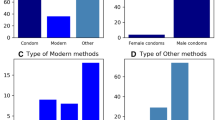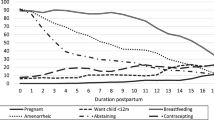Abstract
The objective of this study is to describe the prevalence of postpartum contraceptive use among women experiencing a live birth in Florida in 2004–2005. To examine the association between family planning counseling during prenatal care visits and the use of effective contraceptive methods among postpartum women. Matched data from Florida PRAMS and Vital Statistics were used (n = 3,962). Weighted logistic regression was used to determine the association between prenatal family planning counseling and effective postpartum contraceptive use. Odds ratios were adjusted for use of contraception prior to pregnancy, well-baby checkup, race, ethnicity, nativity, education, marital status, poverty level, stress before or during pregnancy, and parity. Women who reported discussing family planning with their prenatal care provider were more likely to use effective contraception postpartum (AOR: 1.5, 1.1–2.0) compared to women who did not report a discussion. Women who used contraception prior to pregnancy (AOR: 2.3, 1.7–3.2) and women who experienced no stress before or during pregnancy (AOR: 2.0, 1.2–3.4) were also more likely to use contraception in the postpartum period. A significant interaction was identified between family planning counseling during prenatal visits and maternal education. Stratum specific odds ratios for women who received prenatal family planning counseling were significant for women with less than high school education (AOR: 2.5, 1.3–5.1) and for women with high school education (AOR: 2.0, 1.2–3.4). Women reporting family planning counseling during prenatal care were more likely to use effective contraception postpartum. While women with high school or less than high school education levels benefited from prenatal family planning counseling, the greatest benefit was observed for women with less than high school education. Integrating family planning counseling into prenatal care may increase the use of effective contraceptive methods among postpartum women.

Similar content being viewed by others
Abbreviations
- PRAMS:
-
Pregnancy risk assessment monitoring system
- FDA:
-
Food and drug administration
- WIC:
-
Special supplemental nutrition program for women, infants and children
- OR:
-
Odds ratio
- AOR:
-
Adjusted odds ratio
- 95% CI:
-
95% confidence interval
References
Florida Department of Health. Florida PRAMS 2004 and 2005 surveillance data books. Retrieved from http://www.doh.state.fl.us/disease_ctrl/epi/Chronic_Disease/PRAMS/PRAMS2004.pdf, p 40.
Santelli, J., Rochat, R., Hatfield-Timajchy, B., et al. (2003). The measurement and meaning of unintended pregnancy. Perspectives on Sexual and Reproductive Health, 35(2), 94–101.
Zapata, L., Sappenfield, W., Curtis, K. et al. (2010). High contraceptive non-use among women at-risk of unintended pregnancy in Florida. Unpublished manuscript.
Gaudet, L., Kives, S., Hahn, P., et al. (2004). What women believe about oral contraceptives and the effect of counseling. Contraception, 69, 31–36.
Grossman, D., Ellertson, Ch., Abuabara, K., et al. (2006). Barriers to contraceptive use in product labeling and practice guidelines. American Journal of Public Health, 96(5), 791–799.
Nettleman, M., Chung, H., Brewer, J., et al. (2007). Reasons for unprotected intercourse: analysis of the PRAMS survey. Contraception, 75, 361–366.
Miller, V., Laken, M., Ager, J., et al. (2000). Contraceptive decision making among Medicaid-eligible women. Journal of Community Health, 25(6), 473–480.
Barber, S. (2007). Family planning advice and postpartum contraceptive use among low-income women in Mexico. International Family Planning Perspectives, 33(1), 6–12.
Cwiak, C., Gellasch, T., & Zieman, M. (2004). Peripartum contraceptive attitudes and practices. Contraception, 70, 383–386.
American Academy of Pediatrics, American College of Obstetricians and Gynecologists. Intrapartum and Postpartum Care of the Mother. (2007). Guidelines for perinatal care. (5th ed.). 159.
Food and Drug Administration FDA. Birth control guide. Retrieved April 30, 2008 from http://www.fda.gov/fdac/features/1997/babytabl.html.
Ahluwalia, I., Merritt, R., Beck, L., et al. (2001). Multiple lifestyle and psychosocial risk and delivery of small for gestational age infants. Obstetrics and Gynecology, 97, 649–656.
RamaRao, S., Lacuesta, M., Costello, M., et al. (2003). The link between quality of care and contraceptive use. International Family Planning Perspectives, 29(2), 76–83.
Jackson, R., Schwarz, E., Freedman, L., et al. (2000). Knowledge and willingness to use emergency contraception among low-income post-partum women. Contraception, 61, 351–357.
Campbell, J. (2002). Health consequences of intimate partner violence. The Lancet, 359, 1331–1336.
Diamond, I., Newby, M., & Varle, S. (1998). Female education and fertility: Examining the links. National Academy Press, 32–33.
Johnson, L., Edelman, A., & Jensen, J. (1993). Patient satisfaction and the impact of written material about postpartum contraceptive use. American Journal of Obstetric and Gynecology, 188, 1202–1204.
Olds, D., Robinson, J., O’Brien, R., et al. (2002). Home visiting by paraprofessionals and by nurses: A randomized, controlled trial. Pediatrics, 110, 486–496.
Bronstein, J., Vosel, A., George, S., et al. (2007). Extending medical coverage for family planning services: Alabama’s first four years. Public Health Reports, 122, 190–197.
Acknowledgments
The authors thank Dr. Deb Rosenberg for her statistical and analytical contributions and the CDC-PRAMS grant support number 5UR6DP000541-05 who made possible the 2004 and 2005 surveys.
Author information
Authors and Affiliations
Corresponding author
Rights and permissions
About this article
Cite this article
Hernandez, L.E., Sappenfield, W.M., Goodman, D. et al. Is Effective Contraceptive Use Conceived Prenatally in Florida? The Association Between Prenatal Contraceptive Counseling and Postpartum Contraceptive Use. Matern Child Health J 16, 423–429 (2012). https://doi.org/10.1007/s10995-010-0738-9
Published:
Issue Date:
DOI: https://doi.org/10.1007/s10995-010-0738-9




